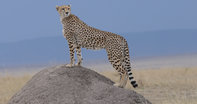
Name
Cheetah (acinonyx jubatus)Appearance
The cheetah is best known for being the fastest land animal over short distances, and can run up to 90 km/h (55.9 m/h) to catch prey. Its slender body, long legs, small, wide-set rounded ears and rounded head, spotted coat and long tail are its most prominent physical characteristics.
From snout to tail, it measures about 2 metres long and 800 mm high, males weighing 40 to 60 kg and females 26 to 48 kg. Its tail has unique striped markings and measures as long as half of its body length.
Cheetah Diet
The cheetah mainly feeds on its prey of steenbok, duiker, Thomson’s gazelle and springbok. It also preys on smaller animals such as baboons, ground-living birds, bustards, porcupines and hares. It has been reported that males group together to hunt wildebeest.Cheetah Breeding
Having no specific breeding season, the cheetah female can give birth throughout the year in South Africa. After a gestation period of three months, 1 - 5 cubs weighing about 272 g are born to a litter.
Cubs stay with their mother until about two years of age, however most do not survive to adulthood due to being preyed upon by leopards, lions, hyenas, foxes and eagles.
Cheetah are comparatively frail cats. To not risk being killed herself, the mother often has to give up her young. In areas of good shelter and few predators, the cheetahs possibility of survival is rather strong.
Cheetah Behaviour
Some individuals prefer to live solitarily, although cheetahs live in family groups of 2 - 6.They are diurnal and most active at sunrise and sunset.
During the hottest times of the day, they lie in high, shaded places. Their call is similar to a bird-like chirp. They also growl, hiss and snarl like domestic cats. Since past times, the cheetah’s distribution in Africa has changed greatly due to modern man’s colonisation of the continent.
Cheetah Habitat
Having been entirely exterminated in the 1930s in KwaZulu-Natal, cheetahs are now a rare and protected species. They can be found in the Kalahari and isolated areas of Limpopo and Mpumalanga in South Africa.
Namibian cheetahs were reintroduced in Hluhluwe-Imfolozi Park and uMkuze Game Reserve in 1965, and on the eastern shore of Lake St. Lucia.
 At some point in their recent history (about ten thousand years ago), cheetah went through a population bottleneck resulting in the fact tha...
At some point in their recent history (about ten thousand years ago), cheetah went through a population bottleneck resulting in the fact tha... Cheetah have long legs, long, flexible spines and wasp-like waist that in combination affect the long strides necessary to run quickly....
Cheetah have long legs, long, flexible spines and wasp-like waist that in combination affect the long strides necessary to run quickly.... Cheetah are predators specialized for speed. Clocking a record speed of 112 km/h, they are undoubtedly the fastest land mammals....
Cheetah are predators specialized for speed. Clocking a record speed of 112 km/h, they are undoubtedly the fastest land mammals.... The cheetah is easily recognized by the presence of two black ‘tear marks’ running down the sides of its nose from the corner of the eye...
The cheetah is easily recognized by the presence of two black ‘tear marks’ running down the sides of its nose from the corner of the eye... Sprinter lacking strength - catches prey by oxygen starvation through a fast chase and subsequent suffocation...
Sprinter lacking strength - catches prey by oxygen starvation through a fast chase and subsequent suffocation... Cheetah are not considered social cats like lions but they do prefer to live in family groups, i.e. a female with her most recent litter, or...
Cheetah are not considered social cats like lions but they do prefer to live in family groups, i.e. a female with her most recent litter, or...